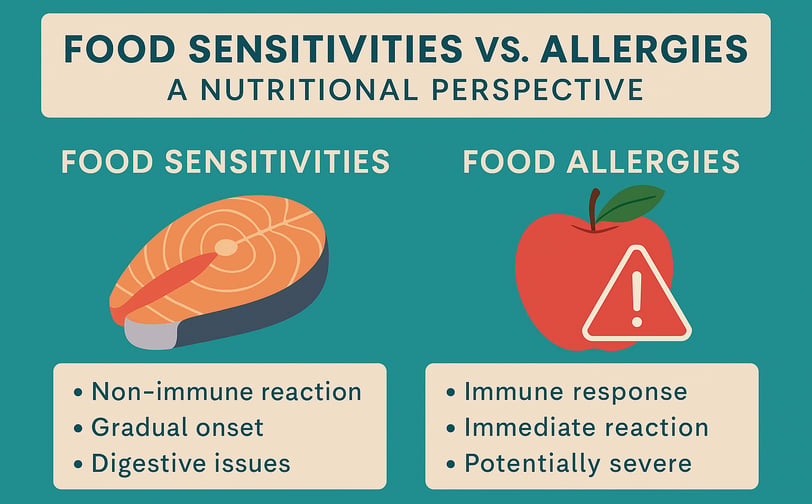Food Sensitivities vs. Allergies: Key Differences & Nutritional Strategies
Learn how to distinguish food sensitivities from allergies, explore evidence-based management strategies, and discover helpful products like enzyme supplements, probiotics, and at-home sensitivity tests to support better digestion and overall wellness.
5/15/20252 min read


Food Sensitivities vs. Allergies: A Nutritional Perspective
Understanding how your body reacts to different foods is critical for long-term health. While both food sensitivities and allergies can cause discomfort, the root causes, severity, and nutritional implications differ. Knowing the difference helps guide safer food choices, smarter supplementation, and better digestive health outcomes.
Breaking Down the Difference
Food allergies are immune reactions that happen quickly—within minutes to hours—after consuming a trigger food. These responses, often driven by IgE antibodies, can be severe, even life-threatening. In contrast, food sensitivities are often slower, milder responses caused by enzyme deficiencies, microbiome imbalances, or IgG antibodies. These typically show up as bloating, fatigue, headaches, or joint pain and may take hours or days to appear after eating a trigger.
What the Research Tells Us
Current science shows that allergies activate histamine release via mast cells, causing acute symptoms like swelling or rashes. Sensitivities may stem from incomplete digestion (like lactose or gluten intolerance) or immune responses that are less dramatic but still harmful over time. Recent studies also link poor gut diversity to heightened sensitivity responses, showing that gut health plays a central role in food tolerance.
Management Strategies That Work
For allergies, the approach is clear: complete avoidance of allergens and the use of emergency treatments like epinephrine if needed. Label reading and restaurant awareness become non-negotiable habits. For sensitivities, however, management may include guided elimination diets, supporting digestion through targeted enzymes, and strengthening the gut lining with probiotics. Working with a dietitian or functional nutritionist can help uncover subtle triggers while preserving dietary variety.
Products to help
1. Everlywell Food Sensitivity Test
An at-home test that measures IgG antibody reactivity to 96 different foods, helping you identify potential food sensitivities.
Buy on Amazon
As a first step in navigating sensitivities, having data helps. This test allows you to take control of your diet by pinpointing hidden trigger foods that may not show up on traditional allergy tests. It’s an ideal tool to kickstart a personalized elimination and reintroduction plan.
2. Enzymedica Digest Spectrum
A digestive enzyme supplement designed to support the digestion of multiple food components, including gluten, lactose, and casein.
Buy on Amazon
For individuals with digestive discomfort after certain meals, a multi-enzyme formula like this can help break down hard-to-digest proteins, fats, and carbohydrates. It's especially helpful during restaurant meals or when your food sensitivity profile is still being explored.
3. VSL#3 Probiotic Supplement
A high-potency probiotic containing eight strains of beneficial bacteria, aimed at restoring gut flora balance and supporting digestive health.
Buy on Amazon
Gut health is central to managing food sensitivities. VSL#3 is backed by clinical research and designed to support microbial balance and immune response, especially in those dealing with bloating, IBS-like symptoms, or food-triggered inflammation.
Final Thoughts
Recognizing the difference between food sensitivities and allergies can improve how you feel on a daily basis. Allergies demand strict avoidance and clinical oversight, while sensitivities benefit from a nuanced, personalized nutritional approach. With the right tools—testing, enzyme support, and targeted gut health strategies—you can take control of your symptoms and feel more in tune with your body. Healing starts with understanding what your body needs—and what it can’t tolerate.
FITNESS
Nutrition
WellnesS
info@movebetterco.com
© 2025. All rights reserved | Privacy Policy | Terms & Conditions